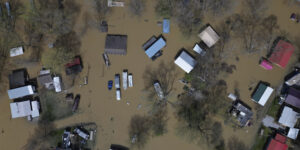Global natural disaster events to the end of Q3 2022 caused total economic losses estimated minimally at $227 billion, of which $99 billion was covered by public and private insurers, which means that insured losses will top $100 billion for the third year in a row, according to Impact Forecasting, Aon’s catastrophe model development team.
This represents an insurance protection gap of 56 percent (or the difference between total economic losses and insured losses), said the Aon report titled “Q3 Global Catastrophe Recap – October 2022.”
The United States accounted for the highest percentage of the economic losses ($114 billion), followed by APAC ($56 billion) and EMEA ($42 billion). Economic losses in the U.S. and EMEA were above average, while APAC saw below-average losses, the report added.
Anticipated insured losses from Hurricane Ian constitute a significant portion of the global insured losses, making tropical cyclone the costliest peril for the insurance industry this year, said Aon, adding that U.S. losses now take up more than 70 percent of the total insured losses year-to-date.
A large portion of losses from Hurricane Ian came from widespread wind-related damage across the Florida peninsula, with most of the impact concentrated along the western and central Florida counties, the report said.
However, additional losses occurred because of “catastrophic storm surge on the western coast and additional inland flooding because of heavy rainfall,” it continued.
Precipitation-induced flooding in inland Florida might have gotten less attention, but “losses from this subperil were not negligible,” Aon said, noting that inland counties generally have lower take-up rates from the National Flood Insurance Program (NFIP), so most of the damage will not be covered by insurance.
“This is in contrast with the coastal counties affected by storm surge, which generally have above-average flood coverage,” the report added.
Even though several firms and entities have issued preliminary statements on expected volume of insured losses for Hurricane Ian, Aon said it is too early to provide a definitive number because of the length of time it will take for damage assessment and liquidation of losses. “The eventual toll will be affected by demand surge, inflation and other factors.”
“It is anticipated that there will be robust loss development across many of the reported natural catastrophes, especially with the realization of costs associated with recent tropical cyclone development worldwide,” commented Michal Lörinc, head of catastrophe insight in Aon’s Impact Forecasting team, in a statement.
“Recurring La Niña conditions and the remainder of tropical cyclone seasons can potentially trigger impactful events through the rest of the year, with additional costs arising from inflationary pressure. Secondary perils can similarly push the overall insured losses for 2022 well beyond $100 billion,” he added.
Secondary perils such as severe convective storm and flooding dominated losses in the first half of the year, while losses from primary perils accelerated in the third quarter due to tropical cyclone activity in the Atlantic and western Pacific, with Hurricane Ian anticipated to be the costliest singular weather event for the year and potentially one of the costliest insured loss events on record globally.
Other findings from the Aon report include:
- Parts of Europe experienced severe drought, amplified by several record-setting heatwaves during the summer of 2022, in mid-June and mid-July, which led to favorable conditions for wildfires. The drought caused economic losses anticipated to approach $20 billion, while more than 16,700 people died as a result of the heatwaves.
- Australia’s east coast floods during Q3 are its costliest event on record.
- July and August were the sixth warmest for the globe dating to 1880, and September tied with 2021 as the fifth warmest, according to statistics from NOAA. September also marked the 453rd consecutive month for global land and ocean temperatures to be above the 20th century baseline average.
- Melting glaciers and prolific monsoonal rain resulted in historic flooding across a wide swath of Pakistan in Q3, killing nearly 1,700 people. Around 20 percent of the deaths were related to indirect causes such as diseases and malnutrition. The actual flood damages and accompanying insured losses were not expected to exceed those seen in China or Australia this year, but the overall impact to the Pakistani economy will be substantial
Source: Aon’s Impact Forecasting
Photograph: Beachgoers survey the damage on Oct. 3, 2022, in Daytona Beach Shores, Fla., as hotel and condo seawalls and pool decks along the Volusia County coastline were gutted by Hurricane Ian last week. Photo credit: Joe Burbank/Orlando Sentinel via AP





















 $1 Trillion! 2024 P/C Industry Direct Premiums At Record Level
$1 Trillion! 2024 P/C Industry Direct Premiums At Record Level  Lemonade: 700K Customers on the Car Waitlist
Lemonade: 700K Customers on the Car Waitlist  Buyer-Friendly April Reinsurance Renewal Bodes Well for Mid-Year Renewals: Brokers
Buyer-Friendly April Reinsurance Renewal Bodes Well for Mid-Year Renewals: Brokers  Insurance Industry Contemplates Knock-On Effect of Tariffs to Claims, Consumers
Insurance Industry Contemplates Knock-On Effect of Tariffs to Claims, Consumers 